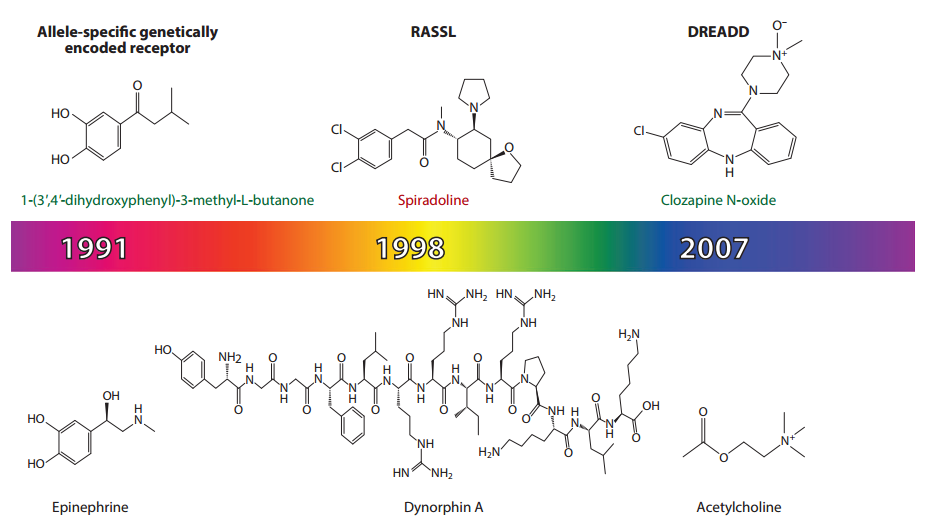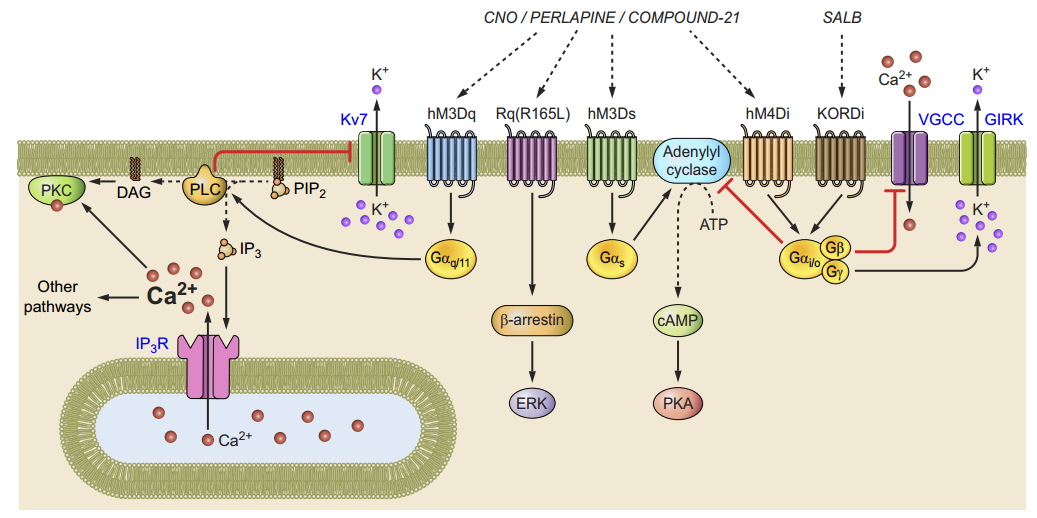Chemogenetics
Chemogenetics integrates chemical reaction and genetic engineering to control cell physiological activities, which usually utilize genetically engineered macromolecules that interact with specific synthetic molecules. The most widely used molecules include G protein-coupled receptors (GPCRs) and ligand-gated ion channels which are engineered so that instead of their endogenous ligands, they respond to particular small molecules.

Evolutionary timeline of GPCR-based chemogenetic approaches listing the main corresponding tools starting with allele-specific engineered β-adrenergic receptors, RASSLs, and DREADDs. Relevant structures shown include (top) engineered ligands and (bottom) endogenous ligands. Green text indicates no pharmacologic activity at the native target; red indicates activity. Abbreviations: DREADD, designer receptor exclusively activated by designer drug; GPCR, G protein–coupled receptor; RASSL, receptor activated solely by synthetic ligand. (Bryan L.Roth.Annu.Rev.Neurosci.2014)
 DREADDs and their downstream intracellular signal transduction pathways.(Deniz Atasoy.Physiol Rev 98: 391–418, 2018)
DREADDs and their downstream intracellular signal transduction pathways.(Deniz Atasoy.Physiol Rev 98: 391–418, 2018)
Chemogenetic Receptor
DREADDs (Designer receptor exclusively activated by designer drug) were engineered from G Protein-Coupled receptors which are relative insensitivity to the endogenous ligandand but could activated by clozapine N-oxide and in turn initiate G-protein signaling cascade and lead to various physiological changes. Below is a list of representative DREADDs.
|
DREADD |
Description |
Ligand |
|
hM3D(Gq) |
Increase Ca2+,Activation |
CNO |
|
hM4D(Gi) |
Decrease cAMP β/γ-GIRK activation, Inhibitory |
CNO |
|
KORD |
Decrease cAMP β/γ-GIRK activation ,Inhibitory |
SALB |
BrainVTA could offer relevant packaging services, for the pre-made AAV tools, please visit the
pre-made AAV center.
Schematic overview of how different variants of DREADDs (hM3Dq and hM4Di) can be used to activate and also inhibit groups of neurons ( http://neuroscience.openetext.utoronto.ca/chapter/3-4-chemogenetic-methods-to-examine-the-brain-and-behaviour/)
Are you designing your experiment? If you have any requisition or questions, you may email us at
sales@brainvta.com or click the
Send Request button.
References
1. Pengfei Wei. et al. Processing of visually evoked innate fear by a non-canonical thalamic pathway
2. Dong S, Rogan SC, Roth BL. Directed molecular evolution of DREADDs: a generic approach to creating next-generation RASSLs. Nat Protoc. 2010 Mar;5(3):561-73
3. Scofield MD, Boger HA, Smith RJ,et al. Gq-DREADD Selectively Initiates Glial Glutamate Release and Inhibits Cue-induced Cocaine Seeking. Biol Psychiatry. 2015 Oct 1;78(7):441-51.
4. López AJ, Kramár E, Matheos DP,et al. Promoter-Specific Effects of DREADD Modulation on Hippocampal Synaptic Plasticity and Memory Formation. J Neurosci. 2016 Mar 23;36(12):3588-99.
5. Deniz Atasoy and Scott M. Sternson. CHEMOGENETIC TOOLS FOR CAUSAL CELLULAR AND NEURONAL BIOLOGY.Physiol Rev 98: 391–418, 2018
6. Hyeong-Min Lee, Patrick M. Giguere, and Bryan L. Roth. DREADDs: novel tools for drug discovery and development .2014 April ; 19(4): 469–473.
7. Scott M. Sternson1 and Bryan L. Roth. Chemogenetic Tools toInterrogate Brain Functions .Annu. Rev. Neurosci. 2014. 37:387–407.


